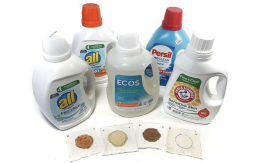The Cold Wash Challenge: Testing How Well Enzymes Work in Laundry Detergents

Summary
What do you think are some of the most common stains on clothes? If you thought of grass, grease, ketchup, blood, or toothpaste stains, you are correct. Everyday activities like eating, playing outside, or doing sports can result in a lot of dirty laundry. Luckily, we have laundry detergents that can get our clothes clean again! Some of these detergents contain enzymes that are intended to boost cleaning power. In this science project, you will investigate how effective biological and non-biological laundry detergents are at different wash temperatures.
This project idea was developed and written by Svenja Lohner, PhD, Science Buddies.
Lohner, Svenja. "The Cold Wash Challenge: Testing How Well Enzymes Work in Laundry Detergents." Science Buddies, 22 Mar. 2023, https://www.sciencebuddies.org/science-fair-projects/project-ideas/GreenChem_p009/green-chemistry/laundy-detergent-enzymes.
This project idea was developed and written by Svenja Lohner, PhD, Science Buddies.
Lohner, Svenja. "The Cold Wash Challenge: Testing How Well Enzymes Work in Laundry Detergents." Science Buddies, 22 Mar. 2023, https://www.sciencebuddies.org/science-fair-projects/project-ideas/GreenChem_p009/green-chemistry/laundy-detergent-enzymes.
Safety Precautions, Hazards, and Risk Assessment
N/A
Teacher Recommendations or Piloting Data (if available)
N/A
Creative Commons License

This work is licensed under a Creative Commons Attribution-NonCommercial-NoDerivatives 4.0 International License.
